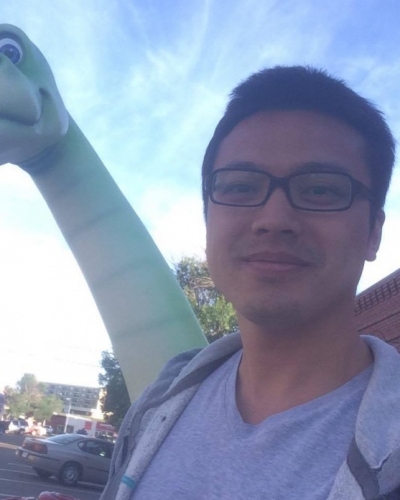CPSH Seminar Series: Hector Garza & Charlie Zheng, UT Jackson School of Geosciences
April 17, 2023
TALK ONE: HECTOR GARZA
Speaker: Hector Garza, Doctoral Degree Student, Department of Geological Sciences, Jackson School of Geosciences
Host: Tim Goudge
Title: How old is the Ordovician-Silurian Boundary at Dob’s Linn, Scotland? Integrating LA-ICP-MS and CA-ID-TIMS U-Pb zircon dates
Abstract: Sedimentary rocks exposed at Dob’s Linn, Scotland, have significantly influenced our understanding of how life evolved over the Ordovician to Early Silurian giving insight to the Late Ordovician Mass Extinction (LOME). The current interpreted chronostratigraphic boundary between the Ordovician and Silurian periods is a Global Boundary Stratotype Section and Point (GSSP), calibrated to 443.8±1.5 Ma (Hirnatian-Rhuddanian age), based on biostratigraphic markers, radioisotopic ages, and statistical modeling. We dated hundreds of zircon grains from three metabentonite ash horizons using Laser Ablation Inductively Coupled Plasma Mass Spectrometry (LA-ICP-MS), and a subset of the grains were re-analyzed using Chemical Abrasion Isotope Dilution Thermal Ionization Mass Spectrometry (CA-ID-TIMS). We present a high-precision CA-ID-TIMS 238U-206Pb weighted mean date of 440.44±0.72 Ma for the Coronagraptus cyphus biozone. However, we report significantly younger and, in some cases, older LA-ICP-MS zircon dates for the Coronagraptus cyphus, Akidograptus ascensus, and Dicellograptus anceps zones as a result of Pb loss and systematic biases. Our results suggest possible biostratigraphic misplacement, identifies concerns with Dob’s Linn’s validity as a GSSP section and examines various LA-ICP-MS maximum depositional age (MDA) approaches consistent with CA-ID-TIMS data.
Biography: Hector Garza is a Ph.D. candidate at the Jackson School of Geosciences Department of Geological Sciences. Before starting the Ph.D. program, Hector spent several years working in the Oil and Gas industry as a geoscientist specializing in clay mineralogy and characterizing reservoirs using geochemistry. As part of his Ph.D. work, Hector is interested in comprehending major geologic and evolutionary events in Earth’s history and systematic biases with the U-Pb system and dating techniques. He is specifically researching the timing of early land colonization by terrestrial biota to understand the development of Earth’s Early Paleozoic biogeochemical cycles and evaluating how life appeared and transformed this planet.
TALK TWO: CHARLIE ZHENG
Speaker: Charlie (Yu-Chen) Zheng, Doctoral Degree Student, Department of Geological Sciences, Jackson School of Geosciences
Host: Tim Goudge
Title: Resilience of marine infaunal communities under a short-lived environmental perturbation: cause of the shelf anoxia and origin of intrashelf basins
Abstract: Investigating the habitat and nature of the earliest animal life on Earth relies on trace-fossil evidence. Since ancient oceans hosting these early lifeforms contain low oxygenation, understanding the infaunal community under oxygen-deficient conditions or reestablishment after environmental perturbations is critical to define the habitability of the environment for metazoan life. A comprehensive dataset documenting oxygen-deficient trace fossil assemblage from different settings and geologic ages is necessary to test the hypothesis. Moreover, to apply the concept in the search for evidence of early lifeforms on other worlds.
Cretaceous intrashelf basins represent a shallow marine ecosystem that is impacted by locally developed anoxia, creating “dead zones” in the shelf that evolve into shallow basins within the shelf. This study aims to comprehensively evaluate the paleoecologic and paleoceanographic conditions for the intrashelf Maverick Basin in south Texas and extend the existing ichnologic database in oxygen-deficient settings within a detailed spatio-temporal framework. Specifically, this study aims to 1) provide a sequence correlation from the reef margin through the shallow platform interior into the intrashelf basins to serve as a detailed spatio-temporal framework and 2) characterize distinctive infaunal communities under hostile, oxygen-limited conditions to define the oxygen content in the sediment interstitial water. This study provides the first example of shelf anoxia and oxygen-constrained trace fossil assemblages in an intrashelf basin lacking modern analogs and serves as an update on such basin settings.
Biography: Charlie Zheng is a Ph.D. candidate at the Department of Geological Sciences, Jackson School of Geoscience, advised by Dr. Charles Kerans. Charlie achieved his master’s degree at the University of Saskatchewan, Canada, where he received training in ichnologic analysis from Drs. Gabriela Mangano and Luis Buatois. Charlie’s research interests are carbonate sedimentology and stratigraphy and applying ichnologic analysis to enhance paleoenvironment reconstruction to better understand paleoclimate and paleoceanography. Charlie’s dissertation focuses on oxygen-deficient sedimentary records from two different settings in the Cretaceous, the intrashelf Maverick Basin and Austin Chalk Group, south Texas.



